Study Material and Notes of Ch 5 Morphology in Flowering Plants Class 11th Biology
Topics in the Chapter
- Classification
- Numerical Taxonomy
- Cytotaxonomy
- Chemataxonomy
- Algae
- Reproduction in Algae
- Bryophytes
- Reproduction in Bryophytes
- Pteridophytes
- Gymnosperms
- Angiosperms
- Life Cycle and Alternation of Generations
Morphology:
The study of various external features of the organism is knownas morphology. The angiosperms are characterized by presence of roots, stems, leaves, flowers and fruits.
| The Root:The root is underground part of the plant and develops from elongation of radicle of the embryo. Various types of root | |
| 1. | Tap root: Originates from radicle. Dicotyledonous plantse.g., mustard,gram, mango. |
| 2. | Fibrous root: Originates from base of the stem. Monocotyledonous plants e.g., wheat, paddy. |
| 3. | Adventitious root: Originates from parts of the plant other than radicle. Banyan tree (Prop roots)Maize (Stilt roots) |
| Root Cap:The root is covered at the apex by the thimble-like structure which protects the tender apical part o the root. | |
Regions of the root: | |||||
| 1. | Region of meristematic activity | : | Cells of this region have the capability to divide. | ||
| 2. | Region of elongation | Cells of this region are elongated and enlarged, responsible for root growth. | |||
| 3. | Region of Maturation | Maturation:This region has differentiated and matured cells. Some of the epidermal cells o thi read-like root hairs for absorption of water and minerals. | |||
| Mo | f Root: | ||||
| Roots are modified for support, storage of food, respiration. | |||||
Modifications of Root
| • | For support | : | Prop roots in Banyan tree, stilt roots in maize and sugarcane. | |
| • | For respiration | : | Pneumatophores in Rhizophora (Mangrove). | |
| • | For storage of food | : | Fusiform (radish), Napiform (turnip), Conical (carrot). | |
| The Stem | : | Stem is the aerial part of the plant and develops from plumule of the embryo.It bears nodes and internodes | ||
| Modifications of Stem | In some plants the stems are modified to perform the function of storage of food, support, protection and vegetative propagation | |||
Modifications of Stem
| • | For food storage | : | Rhizome (ginger), Tuber (potato), Bulb (onion), and Corm(colocasia). | |
| • | For support | : | Stem tendrils of watermelon, pumpkin, cucumber. | |
| • | For protection | : | Axillary buds of stem of Citrus, Bougainvillea get modifiedinto pointed thorns. | |
| • | For vegetative propagation | : | Underground stems of grass, strawberry, lateral branches of mint and jasmine. | |
| • | For assimilation of food | : | Flattened stem of Opuntia contains chlorophylland performs photosynthesis | |
| Venation | : | The arrangement of veins and veinlets in the lamina of leaf. | ||
| The Leaf | : | Develops from shoot apical meristem, flattened, green structure, manufacture the food by photosynthesis. It has bud in axil. A typical leaf has leafbase, petiole and lamina. | ||
Types of Venation: | ||||
| 1. | Reticulate | : | Veinlets form a network as in leaves of dicotyledonous plants(China rose, Peepal). Paralle | |
| 2. | Paralle | : | Veins run parallel to each other as in leaves of monocotyledonous plants (grass, maize). | |
Modifications of Leaves | ||||
| • | Tendrils | : | (Climbing) −Sweet wild pea | |
| • | Spines | : | (Protection) −Aloe, Opuntia, Argemone | |
| Fleshy | : | (Storage) −Onion | ||
| • | Pitcher | : | (Nitrogen Nutrition) −Nepenthes | |
| The Inflorescence | The arrangement of flowers on the floral axis. | |||
| Main types of Inflorescence | ||||
| 1. | Racemose | : | Main axis is unlimited in growth-Radish, Mustard, Amaranthus. | |
| 2. | Cymose | : | Main axis is limited in growth-Cotton, Jasmine, Calotropis. | |
| 3. | Special type | Ficus, Salvia, Euphorbia. | ||
Symmetry of flower | On the basis of no. of | On the basis of position of calyx,corolla, |
Actinomorphic (radial | Trimerous | Hypogynous (superior ovary) |
Zygomorphic (bilateral | Tetramerous | Perigynous (half inferior ovary) |
Asymmetric (irregular) | Pentamerous | Epigynous (inferior ovary) |
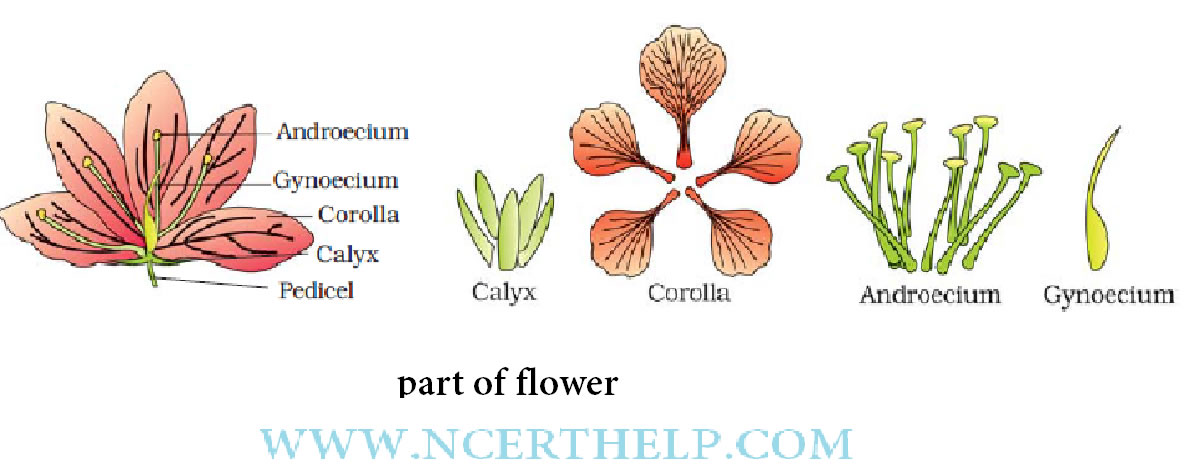
| 1. | Calyx | : | Sepals, green in colour, leaf like.Gamosepalous− (Sepals united)Polyseppalous− (Sepals free) | |
| 2. | Corolla | : | Petals, usually brightly coloured to attract insects forpollinationGamopetalous− (Petals united)Polypetalous − (Petals free) | |
| Aestivation | : | The mode of arrangement of sepals or petals in floral bud with respect to other members of the same whore. | ||
Types of aestivation | ||||
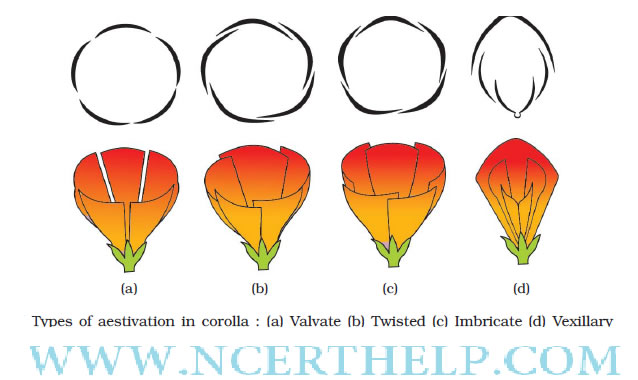
| 1. | Valvate | : | Sepals or petals do not overlap the sepal or petal at margins as inCalotropis. | |
| 2. | Twisted | : | Sepals or petals overlap the next sepal or petal as in China rose. | |
| 3. | Imbricate | : | margins of sepals or petals overlap one another but notin any definite direction as in Gulmohar. | |
| 4. | Vexillary | : | largest petal overlaps the two lateral petals which in turnoverlap two smallest anterior petals as in Pea. (Papilionaceous) | |
| Vexillary | : | If calyx and corolla are not distinguishable (tepals), they are called perianth | ||
| Perianth | ||||
| 3. | Androecium | : | If calyx and corolla are not distinguishable (tepals), they are called perianth | |
| 4. | Gynoecium | : | Made up of one or more carpels, female reproductive part, consists of stigma, style and ovary, ovary bears one or more ovules. Carpels maybe apocarpous(free) or syncarpous (united). After fertilisation, ovules developinto seeds and ovary into fruit. | |
 | Placentation : The arrangement of ovules within the ovary. | |||
Types of Placentation : | ||||
Marginal : Placenta forms a ridge along the ventral suture of ovary as in pea. | ||||
Parietal : Ovules develop on inner wall of ovary as in mustard. | ||||
| ree central : Ovules borne on central axis, lacking septa as in Dianthus. | ||||
| : | Basal : Placenta develops at the base of ovary as in sunflower. | |||
| ||||
The fruit : After fertilization, the mature ovary develops into fruit. The parthenocarpic
fruits are formed from ovary without fertilization.
Structure of a Dicotyledonous Seed:
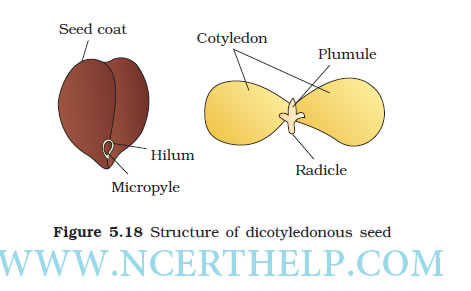
Structure of a Monocotyledonous Seed:
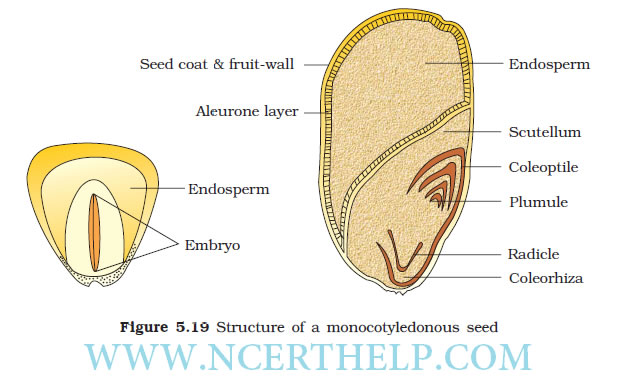
Description of Some Important Families:
1.Fabaceae (Pulse Family)
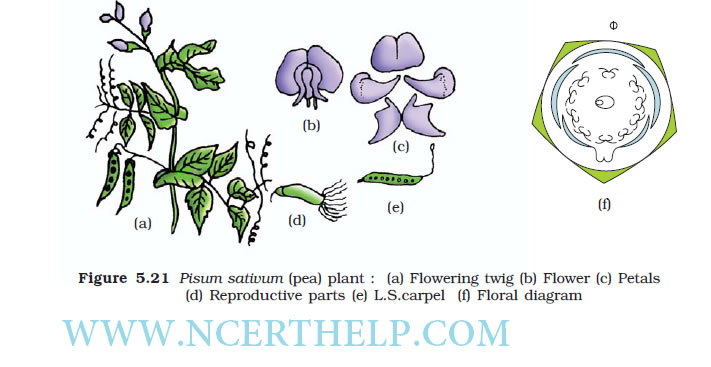
2.Solanaceae (Potato Family)
Floral formula: % ![]() K(5) C1 + 2 + (2) A(9) + 1 G1
K(5) C1 + 2 + (2) A(9) + 1 G1
.jpg)
.jpg)
Floral formula: Br P3+3 A3+3 G(3)
Points to Remember
Morphology: The study of various external features, forms and relative position of different organs of the organism is known as morphology. It may be further divided into internal and external morphology.
External Morphology: It deals with external forms like shape, size, colour, structure and relative position of different organs.
Internal Morphology: Further divided into anatomy and histology.
Anatomy: It deals with the study of internal structure exposed after dissection and opening of various parts of an organ.
Histology: The study of tissues, their composition and structure.
Adaptation: Any alteration in the structure or function of an organism or any of its part that results from natural selection and by which the organism becomes better fitted to survive and multiply in its environment.

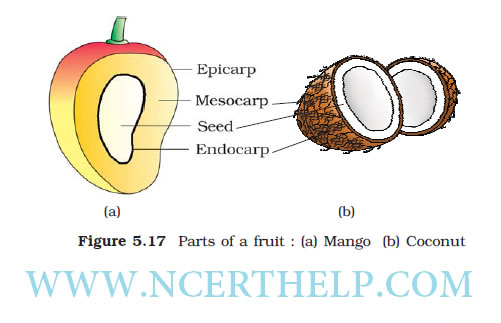




No comments:
Post a Comment